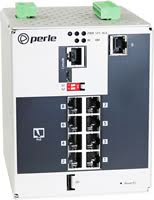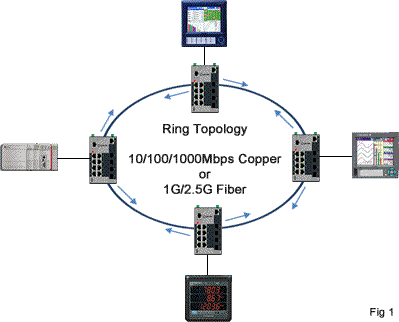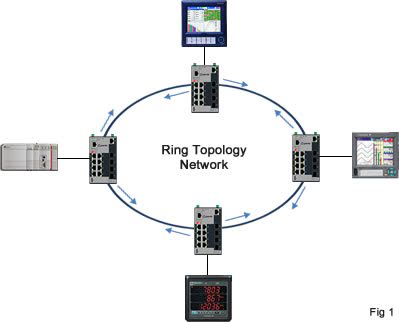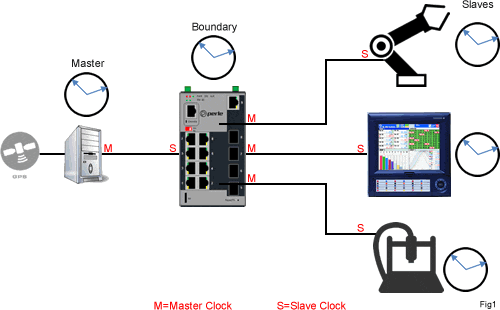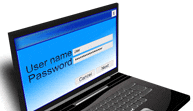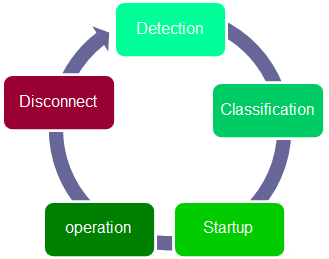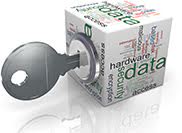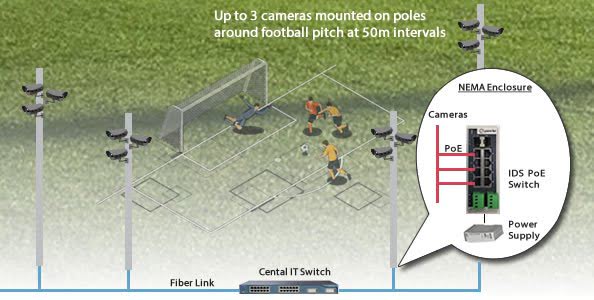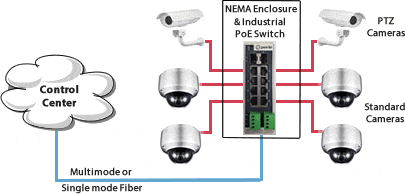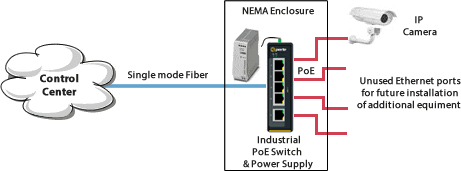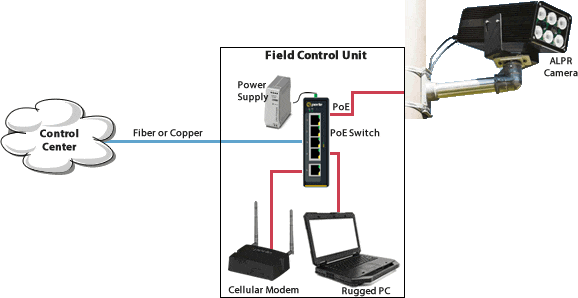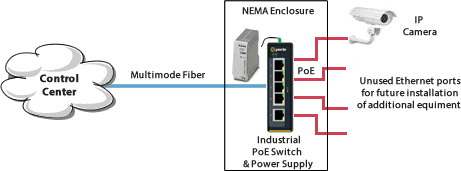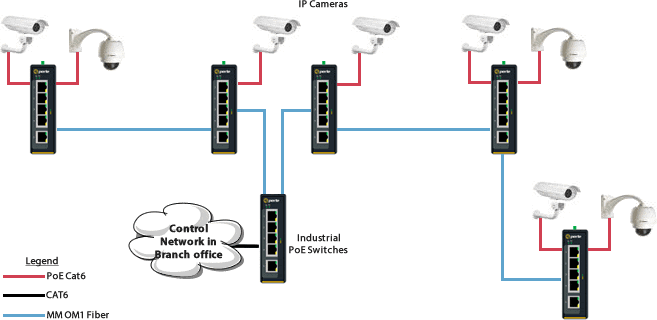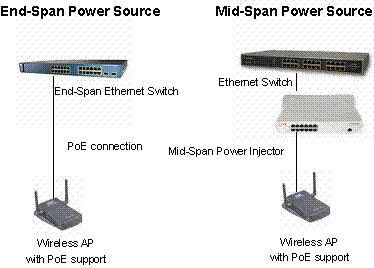IDS-509PP – Managed Industrial PoE+ Switch
Industrial 9 Port Managed Ethernet Switch
- 9 port 10/100/1000Base-T for Gigabit and Fast Ethernet devices
- Advanced switching, VLAN, encryption and IEEE 1588 PTP
- PoE/PoE+ PSE capable ports, fully compliant to IEEE 802.3af/at
- Digital inputs for generation of alerts
- PROFINET and Modbus TCP Protocol Support
- Compact, corrosion resistant case attaches to a standard DIN Rail
- Redundant dual power input 48 VDC
- Programmable Controller safety and Hazardous Location Certification
- -40 to 75C industrial operating temperature
The IDS-509PP is a 9 port Managed Ethernet Switch that can operate in industrial 10/100/1000-Base-T environments providing advanced performance and enabling real-time deterministic network operation. These PoE Switches are classified as Power Sourcing Equipment (PSE). While using standard UTP cables that carry Ethernet data, the IDS-509PP have up to eight (8) ports that also provide up to 30 watts of power to Powered Devices (PDs) such as wireless access points, Voice over IP phones and IP cameras. Learn more about PoE.
Perle Industrial-grade Ethernet Switches are designed to stand up to extreme temperatures, surges, vibrations, and shocks found in industrial automation, government, military, oil and gas, mining and outdoor applications.
Perle’s Fast Setup feature provides simple Plug and Play installation to get your Ethernet devices networked immediately. The familiar Command Line Interface (CLI), via in-band Telnet or the out-band serial console port, will be appreciated by CCNA (Cisco Certified Network Associate) and CCNP (Cisco Certified Network Professional) trained engineers.
The PRO feature set in the IDS-305F is ideal for enterprise-grade level environments where additional extensive security and network integration functionality is required.
- AAA (Authentication, Authorization, Accounting) security protocols: RADIUS and TACACS+
- Secure management sessions via SSH, SNMPv3, Telnet and HTTPS
- Management Access Lists (ACL) by IP address and IP Port number
- Password Strength Checking
- IEEE 802.1x Authentication and Port Security for protection of user access ports
- Optimize the performance and intelligence of the network with Advanced Protocols: LLDP, GVRP, Voice VLANs, MSTP, GMRP, IPv4 IGMP Snooping and IPv6 MLD Snooping
An IPv6 address can be used to manage the IDS-509PP which also supports a comprehensive set of management functions, such as MRP (IEC62439-2), PROFINET, Modbus TCP, management VLAN, QoS, RMON, N:1 port mirroring and local alert log.
The IDS-509PP, which comes in a variety of models, are rugged fan-less switches that are hardened to provide superior reliability in -10 to 60°C, or harsh extended operating temperatures from -40 to 75°C. Every component on every industrial (XT) model has been designed and tested to handle operating temperatures between -40 and 75C.
All Perle Industrial Ethernet Switches only use high-end components from the leading chip manufacturers to ensure the highest level of durability and reliability. In addition, all units have a corrosion resistance aluminum case and dual redundant power input with reverse polarity and overload protection.
Perle has been designing industrial hardware for over 35 years. This expertise was used to design the toughest Ethernet switches on the market that will keep your system running for years to come.
IDS-509 Industrial Managed DIN Rail Switch Features
|
Simple deployment |
Zero-touch discovery using Dynamic Host Control Protocol (DHCP), Perle’s “Fast Setup” for first time installation, provides simple deployment in Ethernet environments |
|
PD Power Reset |
Ideal for remotely resetting equipment, this configurable function performs a power reset to attached Powered Devices (PDs). This is achieved by disabling and then re-enabling PoE on the desired Ethernet copper port. |
|
Security |
802.1X, port security, Secure Shell (SSHv2); SNMPv3 provides encrypted administrator traffic during CLI and SNMP sessions; TACACS+ and RADIUS authentication facilitate centralized control and restrict unauthorized users. |
|
Resiliency |
|
|
Manageability |
|
|
Industrial Ethernet Protocol Support |
Manage Perle IDS-500 switches via PLC, NMS, HMI or SCADA systems using PROFINET or Modbus TCP. |
|
Rugged design for harsh environments |
|
|
Reliable operation |
|
|
Real-time Ethernet performance |
|
Performance Features
Port Auto-sensing
Auto-sensing of port speed and auto-negotiation of duplex on all switch ports for optimizing bandwidth
Auto MDI/MDIX
Medium-dependent interface crossover (Auto-MDIX) capability on 10/100 and 10/100/1000 mbps interfaces that enables the interface to automatically detect the required cable type (straight thru or crossover) and to configure the connection appropriately
802.3x flow control
IEEE 802.3x flow control on all ports. (The switch does not initiate pause frames)
Link Aggregation protocol
Increase port bandwidth through link aggregation. Support is provided for IEEE 802.3ad using Link Aggregation Control Protocol (LACP). Up to eight (8) ports in a single port-channel
Static Link Aggregation
Provides the ability to operate under a static (manual) link aggregation scenario (where the remote switch peer does not support LACP)
Storm Control
Storm control prevents traffic on a LAN from being disrupted by a broadcast, multicast, or unicast storm on one of the physical interfaces. A LAN storm occurs when packets flood the LAN, creating excessive traffic and degrading network performance. Storm Control enables limits to be placed on broadcast, multicast and unicast traffic
Bandwidth Control Monitoring
Bandwidth Control provides the ability to monitor the flow rates on a per port basis and the ability to cause an SNMP trap to occur (selectable) and put the port in an error-disabled
state
Static MAC Addressing
This feature enables the manual configuration of the MAC addresses on a per port basis. Flooding is prevented by retaining MAC entries across a reboot of the switch.
Port Blocking
Port Blocking provides the ability to block the flooding of unknown layer 2 unicast and multicast traffic on an Interface
IPV4 IGMP Snooping
Internet Group Management Protocol (IGMP) constrains the flooding of multicast traffic by dynamically configuring Layer 2 interfaces so that multicast traffic is forwarded to only those interfaces associated with IP multicast devices.
IGMPv1, v2, v3, IGMP snooping querier mode, IGMP report suppression, topology change notification and robustness variable features are supported
IPV6 MLD Snooping
With Multicast Listener Discovery (MLD) snooping, IPv6 multicast data is selectively forwarded to a list of ports that want to receive the data, instead of being flooded to all ports in a VLAN. This list is constructed by snooping IPv6 multicast control packets
GMRP
GARP Multicast Registration Protocol (GMRP) provides a constrained multicast flooding facility similar to IGMP snooping.
GMRP provides a mechanism that allows bridges and end stations to dynamically register group membership information with the MAC bridges attached to the same LAN segment and for that information to be disseminated across all bridges in the Bridged LAN that supports extended filtering services
Port Quick Disconnect
In some network environments, it is desirable to move an Ethernet from one switch port to another and have the device come on-line quickly. The Port Quick Disconnect feature if enabled, provides an immediate age-out of the MAC addresses learned on the port when the port status changes from a link-up to a link-down state
Manageability Features
This Windows-based desktop application helps busy IT managers configure and monitor the status of deployed Perle devices.
Web Device Manager
The Perle Web Device Manager is an embedded Web based application that provides an easy to use browser interface for managing the switch. Operates with both http and secure https streams. Unlike competitive products, Java applet technology is not required or used
Command Line Interface (CLI)
A familiar text-based Command Line Interface that is based on accepted industry standard syntax and structure. Ideal for CCNA and CCNP trained engineers, this interface is available via in-band Telnet/SSH or the out-band serial console port
Industrial Ethernet Protocols
Manage Perle IDS-500 switches via PLC, NMS, HMI or SCADA systems using PROFINET or Modbus TCP.
SNMP
Manage the switch with an SNMP compatible management station that is running platforms such as HP Openview or Perle’s PerleVIEW NMS. SNMP V1 and V2C
PerleVIEW is Perle’s SNMP-based network management system that provides a view of the network with a large scale of Perle networking devices.
IPv6
Manage with an IPv4 or IPV6 address
DHCP Client Auto-Configuration
Automates configuration of switch information such as IP address, default gateway, hostname and Domain Name System (DNS) as well as TFTP server names. Firmware and configuration file locations are provided through options 54, 66, 67, 125 and 150
DHCP Relay
DHCP Relay is used for forwarding requests from DHCP clients when they are not on the same physical subnet. As a DHCP relay agent the switch operates as a Layer 3 device that forwards DHCP packets between clients and servers.
DHCP Option 82 Insertion
Normally used in metro or large enterprise deployments DHCP Option 82 insertion is used to provide additional information on “physical attachment” of the client. As per RFC 3046, option 82 enables additional pre-defined information to be inserted into the DHCP request packet (for DHCP Servers that support this option)
DHCP Server
For networks where a central DHCP server is not provided, the switch can provide a DHCP Server function for allocation of IP addresses to the connected devices
DHCP server port-based address allocation
When Ethernet switches are deployed in the network, they offer connectivity to the directly connected devices. In some environments, such as on a factory floor, if a device fails, the replacement device must be working immediately in the existing network
When configured, the DHCP server port-based address allocation feature ensures that the same IP address is always offered to the same connected port even as the client identifier or client hardware address changes in the DHCP messages received on that port
LLDP
LLDP-Link Layer Discovery Protocol as per IEEE 802.1AB is a neighbor discovery protocol that is used for network devices to advertise information about themselves to other devices on the network. This protocol runs over the data-link layer, which allows two systems running different network layer protocols to learn about each other (via TLVs – Type-Length-Value)
LLDP-MED
LLDP Media Endpoint Discovery is an extension to LLDP that operates between endpoint devices such as IP phones and network devices such as switches. It specifically provides support for voice over IP (VoIP) applications and provides additional TLVs for capabilities discovery, network policy, Power over Ethernet, inventory management and location information
NTP
The switch can provide the time to NTP/SNTP capable client devices (or other switches, etc). You can run the SNTP client and the NTP server concurrently on your system. Therefore you can obtain time from an outside source and serve that time to the devices connected to the switch.
IEEE 1588 – PTP (Precision Time Protocol)
- IEEE 1588 V1 and V2
- Boundary Clock V1
- Boundary Clock V2
- End-to-End Transparent Clock Sync Two Step Operation
- End-to-End Transparent Clock Sync One Step Operation
- Peer-to-Peer Transparent Clock
- End-to-end Boundary clock
- Peer-to-peer boundary clock
- Microsecond accuracy
File Download
Firmware can be transferred via TFTP, SCP, HTTP, HTTPS or via insertion of a microSD card. Text-based files that can be created or edited by common text editors.
Secure Copy Protocol (SCP)
SCP based on the Secure Shell (SSH) protocol, is a means of securely transferring computer files between a local host and a remote host or between two remote hosts.
Power Over Ethernet
Manage the allocation of available power to enabled Power Over Ethernet ports
Availability and Redundancy Features
Spanning Tree Protocol (STP)
IEEE 802.1D now incorporated in IEEE 802.1Q-2014, STP prevents bridge loops and the broadcast radiation that results from them.
Other Spanning Tree features include BPDU guard, Root guard, loop guard, root guard and TCN Guard
Rapid Spanning Tree Protocol (RSTP)
Interoperable with STP, RSTP (IEEE 802.1w) takes advantage of point-to-point wiring and provides rapid convergence of the spanning tree. Reconfiguration of the spanning tree can occur in less than 1 second
Multiple Spanning Tree Protocol (MSTP)
Originally defined in IEEE 802.1s and now incorporated IEEE 802.1Q-2014, defines an extension to RSTP for use with VLANs. The Multiple Spanning Tree Protocol configures a separate Spanning Tree for each VLAN group and blocks all but one of the possible alternate paths within each Spanning Tree.
- Media Redundancy Protocol (IEC 62439-2).
- Fast convergence protocol designed for industrial networks. Recovery time of 10 ms or better in rings composed of up to 14 switches.
- Prevents a switch loop scenario in a ring topology.
P-Ring provides an easy to use method for configuring a ring network using standard spanning tree protocols.
Prevents a switch loop scenario in a ring topology.
Link Standby
A link recovery feature using a primary and backup link. Provides a simple alternative to spanning tree protocols for link redundancy
VLAN Features
VLAN Range
Up to 256 VLANS across a VLAN ID range of 1 to 4000
GVRP
Generic Attribute Registration Protocol (GARP) VLAN Registration Protocol (GVRP) is an application defined in the IEEE 802.1Q standard that allows for the control of VLANs. With GVRP, the switch can exchange VLAN configuration information with other GVRP switches, prune unnecessary broadcast and unknown unicast traffic, and dynamically create and manage VLANs on switches that are connected through 802.1Q trunk ports.
Voice VLANs
Voice VLANs enables one to separate, prioritize, and authenticate voice traffic moving through your network, and to avoid the possibility of broadcast storms affecting VoIP (Voice-over-IP) operation. With an IP Phone connected to an access port, a switchport voice VLAN enables the use of one VLAN for voice traffic and another VLAN for data traffic from an Ethernet device attached to the phone
VLAN Interfaces
Perle switches provide the ability to configure management VLAN interfaces. This enables network administrators to access the switch’s management interface from separate VLAN networks
Security Features
- Provides secure access to switch ports from a central RADIUS server. The switch operating as an authenticator interacting with an 802.1X compliant supplicant (PC or industrial device) through the use of the EAPOL protocol. Authentication will be granted/denied through an external RADIUS server.
- RADIUS assigned VLAN
- IETF 64 (Tunnel Type)
- IETF 65 (Tunnel Medium Type)
- IETF 81 (Tunnel Private Group ID)
- Guest VLAN and Restricted VLANs are supported
- For non-802.1X devices found in industrial applications, the switch can use the client MAC address for authorization through the use if MAB (MAC Authentication Bypass)
- Switch can also be configured as an 802.1X supplicant (edge switch) with an 802.1x-aware upstream switch
Login Banner and MOTD
- A login message banner presented during sign-on can be configured by the network administrator.
- A Message Of The Day can also be created for presentation to an authenticated user.
Many organizations require stringent management over the strength level of their passwords. When enabled, Perle extends this capability to local passwords stored on the switch enforcing strong passwords to be used.
Port Security – Secure MAC Addresses
This port security feature provides the ability to restrict input to an interface by limiting and identifying MAC addresses of the stations allowed to access the port (Access or Trunk) and will take specific actions when violations occur.
Restricting access to management functions can be configured by protocol or IP address selection are provided. This enables administrators to allow only specific workstations using particular protocols to be able to access the management functions of the switch
RADIUS Management Access Authentication
AAA support for RADIUS servers that Authenticate, Authorize and Account management sessions
TACACS+ Management Access Authentication
AAA support for TACACS+ servers that Authenticate, Authorize and Account management sessions
Secure Socket Layer (SSL)
SSL provided for secure browser sessions using HTTPS
Secure Shell (SSH)
SSH provided for secure SSH session for CLI and SCP file transfer sessions
SNMPV3
Support provided for secure version 3 of SNMP
Quality of Service (QoS) and Class of Service (CoS) Features
Classification
IP ToS/DSCP and IEEE 802.1p CoS
Congestion Avoidance
Weighted Fair Queuing or Strict Queuing
Egress Queues and scheduling
- 4 traffic class queues per port
- output queue mapping
- DSCP to output queue mapping
Monitoring Features
Port Mirroring
N:1 Port Mirroring is a method of monitoring network traffic. With port mirroring enabled, the switch sends a copy of one or more ports to a predefined destination port. Selection of Transmit, Receive frames or both can be made
RMON
RMON statistics provided for statistics, history, alarms and events for network monitoring and traffic analysis
Syslog
Facility for logging systems messages to an external SYSLOG server
Alert Log
Facility for logging systems messages locally
Traceroute
Layer 2 traceroute to identify the path that a frame takes from source to destination
Virtual cable test
A test that enables the detection of potential copper cabling issues such as pair polarity pair swaps and excessive pair skew as well as any opens, shorts or any impedance mismatch. Will report the distance in the cable to the open or short.
Power Supply Monitoring
Provides the status of power supplies of the switch
Internal Temperature Monitoring
The internal ambient temperature of the switch can be obtained from the management interfaces
Alarm Processing
The switch can monitor global switch conditions as well as individual ports. These alarms can be configured to send messages to :
- an internal log file
- external Syslog server
- SNMP trap server
- An external alarm device such as a bell, light or other signaling device via the switch’s built-in dry contact alarm relay
Global Status Monitoring Alarms
- Dual power supply alarm
Port Status Monitoring Alarms
- Link Fault Alarm (IE loss of signal)
- Port not forwarding alarm
- Port not operating alarm (failure upon start up tests)
- FCS Bit error rate alarm
Alarm Relay
When enabled, energizes the built-alarm relay triggering an external alarm circuit such as a bell, light or other signaling device according to alarm conditions set
Digital Inputs
Two Digital Inputs are provided that can be used for generation of alarms (SNMP trap, energizing of on-board Alarm Relay,etc)
Power Over Ethernet
Monitor the amount of power allocated to each port
Management and Standards
IEEE Standards
- IEEE 802.3 for 10Base-T
- IEEE 802.3u for 100BaseT(X) and 100BaseX
- IEEE 802.3ab for 1000Base-T
- IEEE 802.3z for 1000BaseX
- IEEE 802.3x for Flow Control
- IEEE 802.1D-2004 for Spanning Tree Protocol
- IEEE 802.1w for Rapid STP
- IEEE 802.1s for Multiple Spanning Tree Protocol
- IEEE 802.1Q for VLAN Tagging
- IEEE 802.1p for Class of Service
- IEEE 802.1X for Authentication
- IEEE 802.3ad for Port Trunk with LACP
- IEEE 802.1AB LLDP
- IEEE 1588v1 PTP Precision Time Protocol
- IEEE 1588v2 PTP Precision Time Protocol
- IEEE 802.3at Power Over Ethernet
Specifications
HTSUS Number:
8517.62.0020
UNSPSC Code:
43222612
ECCN:
5A992
Power
Dual Power Input
Both inputs draw power simultaneously. If one power source fails, the other live source can, acting as a backup, supply enough power to meet the operational needs of the switch.
- 54 VDC nominal 50-57 VDC
- 48 VDC nominal 44 to 57 VDC
Power Connector
- 4-Pin Removable Terminal Block.
- Grounding screw on metal chassis
Overload Current Protection
Fused overload current protection
Reverse polarity protection
The positive and negative inputs can be reversed providing safe and simple power connectivity.
Access Ports
RJ45 PoE Ports
- 8 shielded RJ45 ports for 10/100/1000Base-T up to 100 meters (328 ft)
- Auto-negotiation
- Auto-MDI/MDIX-crossover for use with either crossover over straight-through cable types
- Ethernet isolation 1500 V
- Amount of available power to PoE ports is dependent upon sufficient voltage and power being supplied to the switch
- To supply 30 Watts to PoE+ (IEEE 802.3at type 2) PDs, the power input must be 54 VDC nominal
- To supply 15 Watts to PoE (IEEE 802.3af/at type 1) PDs, the power input must be 48 VDC nominal
RJ45 port (non-PoE)
- 1 shielded RJ45 ports for 10/100/1000Base-T up to 100 meters (328 ft)
- Auto-negotiation
- Auto-MDI/MDIX-crossover for use with either crossover over straight-through cable types
- Ethernet isolation 1500 V
RJ45 Serial Console port
- RJ45 DTE
- Optional rolled and straight thru RJ45 cables and DB adapters are available
USB Serial Console port
MicroUSB Type B female port for serial console management. Used as an alternative port for out of band management connections
Digital Inputs
Two Digital Inputs are provided that can be used for generation of alarms (SNMP trap, energizing of on-board Alarm Relay,etc)
Removable Storage
MicroSD slot
A MicroSD flash card can be inserted for configuration files and firmware backup and restoration
Alarms
Alarm Relay
NC (Normally Closed), NO (Normally Open) dry contact.
1A @ 24V
Switch Properties
Standards
- IEEE 802.3 for 10Base-T
- IEEE 802.3u for 100Base-TX
- IEEE 802.3ab for 1000Base-T
- IEEE 802.3x for Flow Control
- IEEE 802.3at Power Over Ethernet
Processing Type
Store and Forward
MAC Address Table Size
8K
VLAN ID range
1 to 4094
IGMP groups
1024
Packet Buffer Memory
1 Mbit
Indicators
Power
This LED is turned on when the appropriate level of voltage is applied to one or both of the power inputs
System
Indicates whether the switch O/S is operating normally
RJ45 Ethernet
These integrated colored LEDs indicate link, activity and speed for each port.
Alarm
The alarm LED (Red) will be turned on under alarm conditions
P-Ring Master LED
Status of the P-Ring Master
Backup Network Coupling
Indicates whether or not the “Backup Network Coupling” feature is enabled (Redundant links connecting two P-Ring networks)
External Configuration DIP Switches
RM
When enabled, designates this switch as the P-Ring Master
BC
Activate Backup Coupling between 2 ring networks
Environmental Specifications
Operating Temperature Ranges
- Standard temperature models (Std): -10°C to 60°C (14°F to 140°F)
- XT Industrial extended temperature models (Ind) : -40°C to 75°C (-40 F to 167°F)
Storage Temperature Range
Minimum range of -25°C to 70°C (-13°F to 158°F). -40°C to 85°C (-40°F to 185°F) for industrial extended temperature models
Operating Humidity Range
5% to 90% non-condensing
Storage Humidity Range
5% to 95% non-condensing
Operating Altitude
Up to 3,048 meters (10,000 feet)
Chassis
Metal with an IP20 ingress protection rating
Din Rail Mountable
DIN Rail attachment included. Mounts to standard 35 mm DIN rail in accordance with DIN EN 60175.
Removable to accommodate optional Panel/Wall mount kit
MTBF
107,501 Hours
Calculation model based on MIL-HDBK-217-FN2 @ 30°C
Product Weight and Dimensions
Weight
0.79kg (1.74 lbs)
Dimensions (W x H x D)
13 x 12.3 x 10.6 cm (5.12 x 4.84 x 4.17 in)
Packaging
Shipping Weight
1.1kg (2.43lbs)
Shipping Dimensions
20 x 19 x 18 cm (7.87 x 7.48 x 7.09 in)
Standards and Certifications
Safety
- UL/EN/IEC 62368-1
- CAN/CSA C22.2 No. 62368-1
- UL 60950-1
- IEC 60950-1(ed 2); am1, am2
- EN 60950-1:2006+A11:2009+A1:2010+A12:2011+A2:2013
- UL 61010-1 and UL 61010-2-201 (Standard for Safety for Programmable Controllers) Formerly known as UL508
- UL/IEC 61010-1
- UL/IEC 61010-2
- CE Mark
Emissions
- FCC 47 Part 15 Class A
- CISPR 32 / EN 55032
Immunity
- CISPR 35 / EN 55035
- IEC/EN 61000-4-2 (ESD)
- IEC/EN 61000-4-3 (RS)
- IEC/EN 61000-4-4 (EFT)
- IEC/EN 61000-4-5 (Surge)
- IEC/EN 61000-4-6 (CS)
- IEC/EN 61000-4-8 (Magnetic Field)
- IEC/EN 61000-6-2 (General Immunity in Industrial Environments)
Hazardous Locations (Hazloc)
- ANSI/ISA 12.12.01, Class 1 Division 2 Groups A-D (formerly known as UL 1604)
- ATEX Class 1 Zone 2
Contents Shipped
- Industrial Ethernet Switch with DIN Rail attachment
- Terminal block
- Installation guide
Application Diagrams
IDS-509PP Industrial Switch Diagram
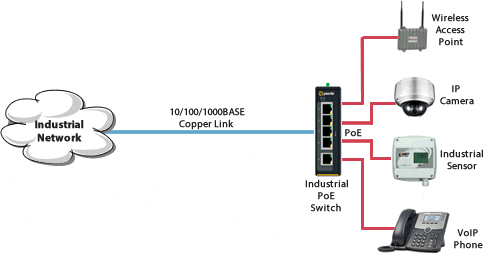
Click on a part number for ordering information
Product Image
Product Description
Power Cord & Part No.

IDS-509PP8 - Industrial Managed Power over Ethernet Switch - 9 ports: 9 x 10/100/1000Base-T RJ-45 ports, 8 of which are PoE/PoE+ capable. -10 to 60C operating temperature. PRO software feature set.

IDS-509PP8-XT - Industrial Managed Power over Ethernet Switch - 9 ports: 9 x 10/100/1000Base-T RJ-45 ports, 8 of which are PoE/PoE+ capable. -40 to 75C operating temperature. PRO software feature set.
Related Accessories
